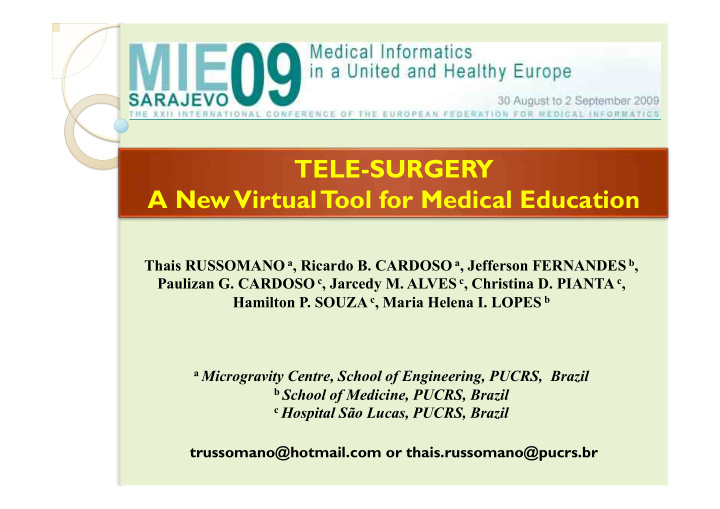



TELE-SURGERY A New Virtual T ool for Medical Education Thais RUSSOMANO a , Ricardo B. CARDOSO a , Jefferson FERNANDES b , Paulizan G. CARDOSO c , Jarcedy M. ALVES c , Christina D. PIANTA c , Hamilton P. SOUZA c , Maria Helena I. LOPES b a Microgravity Centre, School of Engineering, PUCRS, Brazil b School of Medicine, PUCRS, Brazil c Hospital São Lucas, PUCRS, Brazil trussomano@hotmail.com or thais.russomano@pucrs.br
The Microgravity Centre A Pioneer Space Life Sciences Research Centre in Latin America Prof Thais Russomano, MD, MSc, PhD Head, Microgravity Centre/FENG-PUCRS, Brazil www.pucrs.br/feng/microg
The Microgravity Centre Aerospace Biomedical Engineering Laboratory Space Physiology Laboratory + Aviation Physiology & Medicine Laboratory (John Ernsting Aerospace Physiology Lab) Aerospace Pharmacy Laboratory Aerospace Physiotherapy Laboratory Aerospace Biomechanics Laboratory Aviation Research Laboratory Telemedicine Laboratory
T elemedicine and eHealth Lab Coordination – Thais Russomano Technical Assistant – Ricardo Cardoso Research & Development eHealth Assistance eHealth Education Cooperation Scientific Publications Participation in Meetings Announcement of Opportunities = $$$$$
eHealth Education TELE-SURGERY A New Virtual T ool for Medical Education School of Medicine/PUCRS Sao Lucas Hospital 6
Introduction T echnical Expertise in Scientific Knowledge Surgery Increasing demand of surgeons for easy and full access to high-quality information AND Growth in medical specialization No qualified teachers Lack of enough Medical or experts in certain specialists to provide Centers subspecialties the required support
Introduction Availability DEVELOPMENT OF COMUNICATION T ools TECHNOLOGIES Capability e-Health Education Programs Greater interaction Virtual participation
Introduction Benefits of e-Health Programs Surgeon • More control over what the students can observe; • Minimum distraction from the procedure. Patient • Decrease in the possibility of contamination; • Decrease in the incidence of infection in the post-operative patient.
Objectives T o allow… undergraduate students from the school of medicine and other health related areas to virtually experience surgical procedures and lectures. T o facilitate… better access to the operating the learning process by theater and surgeon enabling undergraduate an improved view of the patient students to have and the surgical procedure
Objectives T o lower the risk … of infection in the post-operative patient by reducing the number of people in theater during the surgical procedure; T o introduce… undergraduate students to new concepts of medical care, remote second opinion and telecommunication systems; T o demonstrate… new virtual education methodologies and tools to both professors and students.
Methodology School of Medicine eHealth Student Sao Lucas League Hospital T elemedicine Laboratory of the Microgravity Centre
Methodology Surgery Theater Signal Concentration Point 150m coaxial cables Lecture Hall
Methodology Sony data show T otal view of projector the procedure Professor in the lecture hall • T o choose from three sets of images • T o communicate with the surgeon using a wireless microphone
Methodology Students Signal Concentration Kaunas University of Point Medicine Audio/Video Conversion Portable Image Acquisition Device SKYPE SKYPE Image & Video Conference Video Conference Sound Software Software 11836 Km
Results From January to June of 2008 • 4 T ele-surgery lectures; • T otal of 6 hours; • 2 lectures transmitted to Kaunas University of Medicine, Lithuania. Accomplishments • Anatomical structures and the surgical procedures displayed on a large screen; • Questions answered without distracting the surgeon; • Reduced risk of exposing the patient to additional contamination; • Both the professor in the lecture hall and the remote surgeon were available for questions.
Results Surgery Recordings
Conclusion T elemedicine • Important tool in improving medical education and health care; • Gives the opportunity for greater interaction during surgical procedures. Our Study Demonstrated • The feasibility and acceptability of presenting virtual surgeries and lectures to medical students; • The benefits of moving the students from the surgery theater to the lecture hall; • The involvement of an international partner due to the addition of digital equipment to the system.
INVITATION BE PART OF THE PUCRS eHEALTH PROGRAM!!!! TELE-SURGERY A New Virtual T ool for Medical Education Thais RUSSOMANO a , Ricardo B. CARDOSO a , Jefferson FERNANDES b , Paulizan G. CARDOSO c , Jarcedy M. ALVES c , Christina D. PIANTA c , Hamilton P. SOUZA c , Maria Helena I. LOPES b a Microgravity Centre, School of Engineering, PUCRS, Brazil b School of Medicine, PUCRS, Brazil c Hospital São Lucas, PUCRS, Brazil trussomano@hotmail.com or thais.russomano@pucrs.br
Methodology Camera • Mean distance of 80cm away from the surgery field • 520 lines of resolution • Manual focus (adjusted by a technician via remote control) Signal modulation systems • Frequency range of 60 MHz to 66 MHz • Point-to-point • Coaxial Cables
Recommend
More recommend